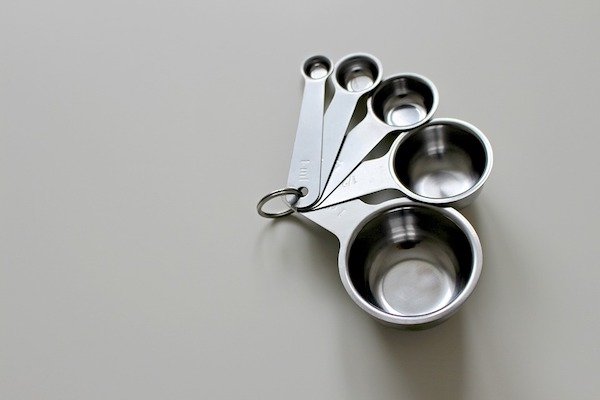If you want to successfully make bread, you have to know more about what goes into your dough, its composition and chemistry. Choosing the right ingredients will get you delicious bread with good form that keeps for several days or weeks. So understanding what each ingredient does and their ratios amongst other ingredients will help get you optimal results.
Disclaimer: some links used in this post are affiliate links, which means I will earn a small commission if you purchase using my provided links at no extra cost to you. I only recommend products I think will be helpful to you and bring you one step closer to creating tasty bread masterpieces!
How to Properly measure bread flour
The amount of flour and water is very important when making bread, since these change the crumb and texture of the bread.
Professional bakers use a system of percentages called Bakers’ Percentage when following recipes and making formulations. They measure all the ingredients according to weight instead of volume.
Measuring by weight using the right tools (our favorite being this one) becomes more accurate and consistent, compared to volume measuring. Dry ingredients are also easier to measure when weighed.

When measuring, flour always has 100% and all other ingredients get a percentage of that amount according to weight.
For example, table bread that is commonly eaten in American households uses about 50% water, leading to light and finely textured bread; artisan bread formulas usually have 60% to 75% water. In yeast bread types, high water percentages lead to CO2 bubbles, plus a coarser bread crumb.
One pound of flour will result to a regular loaf bread or 2 french loaves.
What is in bread flour?
Flour is a product created from grain which has been ground into a powdery consistent form. Flour gives the primary structure to the final baked bread.

Common available flours are created from barley, maize, rye and other grains. Wheat flour is most commonly used for bread-making, since each grain provides much needed protein and starch to the resulting product.
Wheat flour, aside from its starch, also has 3 water soluble protein groups, globulin, albumin, proteoses and 2 non-water soluble protein groups called gliadin and glutenin.
When flour mixes with water, the water-soluble proteins dissolve, which trigger gliadin and glutenin to create the structure of the remaining dough.
Glutenin creates strands of long thin and chain-like molecules when kneaded, while gliadin creates bridges between glutenin strands. The networks of strands create by the 2 proteins are called gluten, a component that boosts the quality of the dough. #glutenforlife
What kind of liquids can I use for baking bread?
Water or any other liquid can be used to mix with flour and turn it into dough or a paste for bread.
The volume of liquid needed will change between recipes, although a ratio of 1 cup of liquid to 3 flour cups is basic for yeast breads. Recipes using steam as a main leavening procedure can have liquid content in excess of 1 part liquid to 1 part flour according to volume.
Aside from water, other liquids can be used to make bread such as fruit juice, dairy products and/or beer. These can provide added fats, sweeteners and leavening components to your delectable loafs.
Are all Bread Recipes the same?
In case you haven’t figured this out already, there are a ton of bread recipes out there, each with their own uniquely tasty results, but it’s important that you stick to the ratios provided. Eventually, the more bread-making practice you have under your belt, the more you can experiment with the amounts to get the consistency, flavor and texture that you prefer.
And if you’re looking to flex your baking creativity and play with ratios (and understand how to do it like a pro), this book is a great pocket guide to deliciousness.
Some countries have varying components to provide more uniqueness and creativity to the mix. Once you get the hang of bread making, you can go wild with your recipes to make something new and delicious every time.


